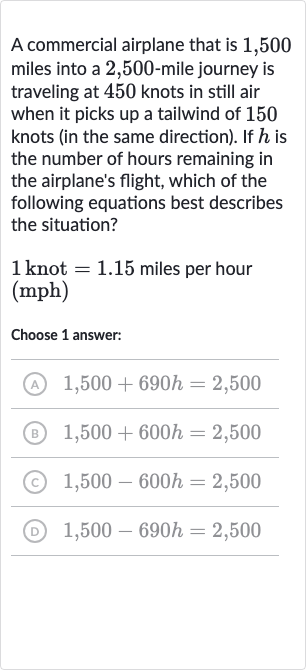AI tutor
Welcome to Bytelearn!
Let’s check out your problem:

A commercial airplane that is , miles into a , -mile journey is traveling at knots in still air when it picks up a tailwind of knots (in the same direction). If is the number of hours remaining in the airplane's flight, which of the following equations best describes the situation? miles per hour (mph)Choose answer:(A) (B) (C) (D)
Full solution
Q. A commercial airplane that is , miles into a , -mile journey is traveling at knots in still air when it picks up a tailwind of knots (in the same direction). If is the number of hours remaining in the airplane's flight, which of the following equations best describes the situation? miles per hour (mph)Choose answer:(A) (B) (C) (D)
- Calculate Effective Speed: Determine the airplane's effective speed with the tailwind.The airplane's speed in still air is knots, and it picks up a tailwind of knots. We need to add these two speeds to find the effective speed of the airplane with the tailwind.Effective speed = knots + knots = knots
- Convert to mph: Convert the effective speed from knots to miles per hour (mph). knot mph, so we need to multiply the effective speed in knots by this conversion factor to get the speed in mph. Speed in mph knots mph/knot mph
- Set Up Equation: Set up the equation to find the remaining hours of flight.The airplane has already traveled miles and has miles left to complete the -mile journey. The speed of the airplane with the tailwind is mph. We use the formula , where time is represented by (the number of hours remaining). miles mph miles
- Verify Equation: Verify that the equation makes sense in the context of the problem.The equation represents the initial distance traveled ( miles) plus the distance that will be covered in the remaining hours of flight () to equal the total journey distance ( miles). This equation correctly represents the situation described in the problem.The equation matches with the option (A).
More problems from Write a linear inequality: word problems
QuestionGet tutor help
QuestionGet tutor help
QuestionGet tutor help
QuestionGet tutor help
QuestionGet tutor help
QuestionGet tutor help
QuestionGet tutor help
